Research Goals:
Our primary goal for this mission is to use the multibeam sonar survey
to produce a high definition 3-D map of the bottom that will help us
define the exact extent of the reef system. Previous fathometer surveys
have been incomplete. The multibeam survey will provide details never
possible before. With continued funding our future goals are: to determine
how much live reef is left, to determine the extent of dead coral and
damage from trawling, and to continue long-term monitoring of fish populations
to see whether the fishing ban is helping with the recovery. Reef balls
have also been deployed in the crushed areas of the reefs to provide
habitat and structure for fish and coral to recover.
What are Oculina Reefs:
The deep-water Oculina coral reefs off central eastern Florida are unique
and occur nowhere else on earth. They are made entirely by a single
species of coral, the Ivory Tree Coral, Oculina varicosa. These form
mounds and pinnacles that are up to 100 feet tall and provide habitat
for an incredible diversity of fish and invertebrates. These reefs grow
below the Gulf Stream at depths of 200 to 300 feet deep, along the edge
of the continental shelf from Fort Pierce to Daytona Beach. In 1984,
NOAA and the National Marine Fisheries designated a 92 sq. mile portion
of the Oculina reefs as a marine reserve in order to protect the coral
from bottom trawling and anchoring. In 2002, the Oculina reserve was
expanded to 300 sq. miles, from Fort Pierce to Cape Canaveral; it is
called the Deep-water Oculina Habitat Area of Particular Concern (OHAPC).
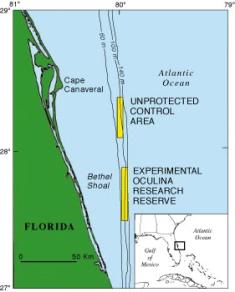
The Importance of Oculina Coral as Habitat:
The Oculina coral provides habitat for an incredible diversity of fish
and associated invertebrates including 70 species of fish, 230 species
of mollusks, and 50 species of decapod crustaceans (crabs and shrimp).
Fish species include various grouper (gag, scamp, snowy, speckled hind,
warsaw), snapper, drum, porgies, sharks, amberjack, tuna, mackerel,
and giant ocean sunfish. Large populations of gag and scamp grouper
use these reefs as feeding and breeding grounds. Unfortunately by the
late 1980s the fish populations had been severely decimated from over
fishing, and in 1994 the South Atlantic Fishery Management Council (SAFMC)
placed a 10-year moratorium on bottom fishing to see if the grouper
populations could recover. Since some of these grouper species do not
breed until they are 10-15 years old, recovery will be a slow process.
Oculina is Delicate and Slow Growing:
Oculina coral is as fragile as china and is very slow growing. Deep-water
Oculina only grows about 1/2" per year. Bushes of Oculina grow
3-5 feet tall and may be centuries old. The reefs themselves may be
over 10,000 years old.
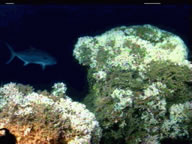
Fig. (A large coral head
of Oculina Varicosa, this particular coral head is over a century old.)
Human Impacts:
Unfortunately some areas of the Oculina reefs have been severely impacted
by human activities primarily from destructive fishing such as bottom
trawling destroying vast areas of the coral. As recently as last year
shrimp trawlers were caught poaching within the OHAPC and 8000 pounds
of shrimp were confiscated. Bottom fishing also can impact the coral
from heavy weights and fishing lines entangling the delicate coral and
over fishing has certainly impacted the fish populations.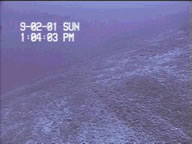
Fig. (This area on the
seafloor flourished with Oculina Varicosa, now it is a bed of broken
coral rubble. This section of reef was probably mowed down by a trawl
net, if you look closely you can see the ridges in the sediment where
the heavy “doors” of the trawl net have left their mark.)
Management Goals:
The recommended management goals and objectives are: to protect and
conserve the unique and fragile coral habitat; to ensure commercial
and recreational fish stocks; to create public awareness, education
and research; and to regulate activities that could harm habitat but
still allow non-detrimental commercial and recreational usage of these
resources. In 2004 the SAFMC will reassess the ban on bottom fishing.
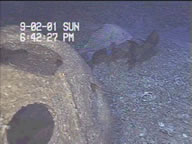
Fig. (A reef ball has been
placed in an area of destroyed reef, to improve the growth of Oculina
corals and to provide habitat for native species.)
The Future:
Submersible studies in 2001 have documented that the populations of
scamp, gag, and snowy grouper appear to be greater than in 1994 prior
to the fishing ban. Although they are still nowhere near the population
densities present in the early 1980s, the good news is that they appear
to be beginning to recover. Our studies have also shown that the grouper
especially are attracted to the healthy reefs and very few are found
on the dead reefs. It is imperative that we continue to educate the
public, our government agencies, as well as commercial and recreational
fishermen that these reefs are unique, irreplaceable resource. We also
need better protection now. Although surveillance and enforcement will
never be 100%, we must prevent any future damage from irresponsible
poachers.
As you can see, our mission is vital to the survival of this one-of-a-kind
resource. Public awareness is the key!
SPECIAL FEATURE:
To keep you glued to your computer screen we're going to feature an
interview with a different scientist or crew member each day and get
the scoop on their job and how they got there…
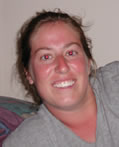 Today we're going to interview scientist Stacey Harter (pictured
left), from the National Marine Fisheries Service (NMFS). The
NMFS is a branch of NOAA (National Oceanographic and Atmospheric Association).
Stacey is a Fisheries Biologist. She decided she wanted to go into marine
science when, as a teenager, she was watching a special on the Discovery
Channel about dolphins. It was then that she realized you can actually
have a job and get paid for doing marine science! During her undergraduate
studies Stacey did an internship in the labs at NMFS and ended up getting
hired there after she graduated. She has a Bachelor's degree in Biology
with an emphasis on marine science and recently got her Master's degree
in marine science.
Today we're going to interview scientist Stacey Harter (pictured
left), from the National Marine Fisheries Service (NMFS). The
NMFS is a branch of NOAA (National Oceanographic and Atmospheric Association).
Stacey is a Fisheries Biologist. She decided she wanted to go into marine
science when, as a teenager, she was watching a special on the Discovery
Channel about dolphins. It was then that she realized you can actually
have a job and get paid for doing marine science! During her undergraduate
studies Stacey did an internship in the labs at NMFS and ended up getting
hired there after she graduated. She has a Bachelor's degree in Biology
with an emphasis on marine science and recently got her Master's degree
in marine science.
Stacey's duties include a juvenile reef fish recruitment project, which
helps scientists predict the future population of specific fish species
such as certain grouper and snapper. For this project she catches fish
in a trawl net and measures them. For those that are already dead, she
takes them back to the lab to determine their ages. Another project
she is working on is on the W. Florida Shelf Marine Reserves. There,
she studies the effectiveness of the marine reserve with remotely operated
vehicles (ROV's), fish traps and video.
Stacey says the best part of her job is that she has a good mix of
field and lab work and isn't stuck in either one all the time. If she
had to pick something she likes the least it would be that being in
the lab for long periods of time can get rather boring!


